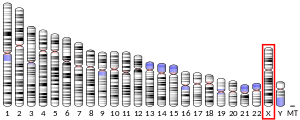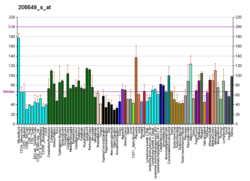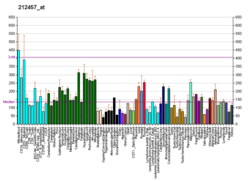TFE3
Transcription factor E3 is a protein that in humans is encoded by the TFE3 gene.[5][6][7]
Function
TFE3, a member of the helix-loop-helix family of transcription factors, binds to the mu-E3 motif of the immunoglobulin heavy-chain enhancer and is expressed in many cell types (Henthorn et al., 1991).[supplied by OMIM][7]
Interactions
TFE3 has been shown to interact with:
Translocations
A proportion of renal carcinomas (RCC) that occur in young patients are associated with translocations involving the TFE3 gene at chromosome Xp11.2 PRCC
gollark: Usually I stick my stuff in VS, Hatchling Club, AoND, Silvi's and DragHatch if I want it to hatch fast.
gollark: I didn't actually use DC back when EATW was around, but it sounded good...
gollark: Well, that's annoying. I'll just gift the pyralspite.
gollark: ```You traverse the forest in search of the rumored dragon graveyard, but despite your best efforts, you are unable to find anything.```
gollark: So why are there *two*?
References
- GRCh38: Ensembl release 89: ENSG00000068323 - Ensembl, May 2017
- GRCm38: Ensembl release 89: ENSMUSG00000000134 - Ensembl, May 2017
- "Human PubMed Reference:". National Center for Biotechnology Information, U.S. National Library of Medicine.
- "Mouse PubMed Reference:". National Center for Biotechnology Information, U.S. National Library of Medicine.
- Puck JM, Stewart CC, Henthorn PS (May 1991). "A high-frequency RFLP at the human TFE3 locus on the X chromosome". Nucleic Acids Res. 19 (3): 684. doi:10.1093/nar/19.3.684-a. PMC 333678. PMID 1672758.
- Henthorn PS, Stewart CC, Kadesch T, Puck JM (Feb 1992). "The gene encoding human TFE3, a transcription factor that binds the immunoglobulin heavy-chain enhancer, maps to Xp11.22". Genomics. 11 (2): 374–8. doi:10.1016/0888-7543(91)90145-5. PMID 1685140.
- "Entrez Gene: TFE3 transcription factor binding to IGHM enhancer 3".
- Giangrande PH, Hallstrom TC, Tunyaplin C, Calame K, Nevins JR (Jun 2003). "Identification of E-box factor TFE3 as a functional partner for the E2F3 transcription factor". Mol. Cell. Biol. 23 (11): 3707–20. doi:10.1128/mcb.23.11.3707-3720.2003. PMC 155231. PMID 12748276.
- Steingrimsson E, Tessarollo L, Pathak B, Hou L, Arnheiter H, Copeland NG, Jenkins NA (Apr 2002). "Mitf and Tfe3, two members of the Mitf-Tfe family of bHLH-Zip transcription factors, have important but functionally redundant roles in osteoclast development". Proc. Natl. Acad. Sci. U.S.A. 99 (7): 4477–82. doi:10.1073/pnas.072071099. PMC 123673. PMID 11930005.
- Mansky KC, Sulzbacher S, Purdom G, Nelsen L, Hume DA, Rehli M, Ostrowski MC (Feb 2002). "The microphthalmia transcription factor and the related helix-loop-helix zipper factors TFE-3 and TFE-C collaborate to activate the tartrate-resistant acid phosphatase promoter". J. Leukoc. Biol. 71 (2): 304–10. PMID 11818452.
- Grinberg AV, Kerppola T (Mar 2003). "Both Max and TFE3 cooperate with Smad proteins to bind the plasminogen activator inhibitor-1 promoter, but they have opposite effects on transcriptional activity". J. Biol. Chem. 278 (13): 11227–36. doi:10.1074/jbc.M211734200. PMID 12551947.
- Hua X, Miller ZA, Wu G, Shi Y, Lodish HF (Nov 1999). "Specificity in transforming growth factor beta-induced transcription of the plasminogen activator inhibitor-1 gene: interactions of promoter DNA, transcription factor muE3, and Smad proteins". Proc. Natl. Acad. Sci. U.S.A. 96 (23): 13130–5. doi:10.1073/pnas.96.23.13130. PMC 23912. PMID 10557285.
Further reading
- Beckmann H, Kadesch T (1991). "The leucine zipper of TFE3 dictates helix-loop-helix dimerization specificity". Genes Dev. 5 (6): 1057–66. doi:10.1101/gad.5.6.1057. PMID 2044953.
- Beckmann H, Su LK, Kadesch T (1990). "TFE3: a helix-loop-helix protein that activates transcription through the immunoglobulin enhancer muE3 motif". Genes Dev. 4 (2): 167–79. doi:10.1101/gad.4.2.167. PMID 2338243.
- Zhao GQ, Zhao Q, Zhou X, Mattei MG, de Crombrugghe B (1993). "TFEC, a basic helix-loop-helix protein, forms heterodimers with TFE3 and inhibits TFE3-dependent transcription activation". Mol. Cell. Biol. 13 (8): 4505–12. doi:10.1128/mcb.13.8.4505. PMC 360062. PMID 8336698.
- Sidhar SK, Clark J, Gill S, Hamoudi R, Crew AJ, Gwilliam R, Ross M, Linehan WM, Birdsall S, Shipley J, Cooper CS (1997). "The t(X;1)(p11.2;q21.2) translocation in papillary renal cell carcinoma fuses a novel gene PRCC to the TFE3 transcription factor gene". Hum. Mol. Genet. 5 (9): 1333–8. doi:10.1093/hmg/5.9.1333. PMID 8872474.
- Weterman MA, Wilbrink M, Geurts van Kessel A (1997). "Fusion of the transcription factor TFE3 gene to a novel gene, PRCC, in t(X;1)(p11;q21)-positive papillary renal cell carcinomas". Proc. Natl. Acad. Sci. U.S.A. 93 (26): 15294–8. doi:10.1073/pnas.93.26.15294. PMC 26398. PMID 8986805.
- Clark J, Lu YJ, Sidhar SK, Parker C, Gill S, Smedley D, Hamoudi R, Linehan WM, Shipley J, Cooper CS (1997). "Fusion of splicing factor genes PSF and NonO (p54nrb) to the TFE3 gene in papillary renal cell carcinoma". Oncogene. 15 (18): 2233–9. doi:10.1038/sj.onc.1201394. PMID 9393982.
- Hua X, Liu X, Ansari DO, Lodish HF (1998). "Synergistic cooperation of TFE3 and smad proteins in TGF-beta-induced transcription of the plasminogen activator inhibitor-1 gene". Genes Dev. 12 (19): 3084–95. doi:10.1101/gad.12.19.3084. PMC 317197. PMID 9765209.
- Steingrímsson E, Tessarollo L, Reid SW, Jenkins NA, Copeland NG (1999). "The bHLH-Zip transcription factor Tfeb is essential for placental vascularization". Development. 125 (23): 4607–16. PMID 9806910.
- Hua X, Miller ZA, Wu G, Shi Y, Lodish HF (1999). "Specificity in transforming growth factor beta-induced transcription of the plasminogen activator inhibitor-1 gene: interactions of promoter DNA, transcription factor muE3, and Smad proteins". Proc. Natl. Acad. Sci. U.S.A. 96 (23): 13130–5. doi:10.1073/pnas.96.23.13130. PMC 23912. PMID 10557285.
- Weterman MJ, van Groningen JJ, Jansen A, van Kessel AG (2000). "Nuclear localization and transactivating capacities of the papillary renal cell carcinoma-associated TFE3 and PRCC (fusion) proteins". Oncogene. 19 (1): 69–74. doi:10.1038/sj.onc.1203255. PMID 10644981.
- Hua X, Miller ZA, Benchabane H, Wrana JL, Lodish HF (2000). "Synergism between transcription factors TFE3 and Smad3 in transforming growth factor-beta-induced transcription of the Smad7 gene". J. Biol. Chem. 275 (43): 33205–8. doi:10.1074/jbc.C000568200. PMID 10973944.
- Ladanyi M, Lui MY, Antonescu CR, Krause-Boehm A, Meindl A, Argani P, Healey JH, Ueda T, Yoshikawa H, Meloni-Ehrig A, Sorensen PH, Mertens F, Mandahl N, van den Berghe H, Sciot R, Dal Cin P, Bridge J (2001). "The der(17)t(X;17)(p11;q25) of human alveolar soft part sarcoma fuses the TFE3 transcription factor gene to ASPL, a novel gene at 17q25". Oncogene. 20 (1): 48–57. doi:10.1038/sj.onc.1204074. PMID 11244503.
- Weterman MA, van Groningen JJ, den Hartog A, Geurts van Kessel A (2001). "Transformation capacities of the papillary renal cell carcinoma-associated PRCCTFE3 and TFE3PRCC fusion genes". Oncogene. 20 (12): 1414–24. doi:10.1038/sj.onc.1204213. PMID 11313885.
- Heimann P, El Housni H, Ogur G, Weterman MA, Petty EM, Vassart G (2001). "Fusion of a novel gene, RCC17, to the TFE3 gene in t(X;17)(p11.2;q25.3)-bearing papillary renal cell carcinomas". Cancer Res. 61 (10): 4130–5. PMID 11358836.
- Chung MC, Kim HK, Kawamoto S (2001). "TFEC can function as a transcriptional activator of the nonmuscle myosin II heavy chain-A gene in transfected cells". Biochemistry. 40 (30): 8887–97. doi:10.1021/bi002847d. PMID 11467950.
- Dintilhac A, Bernués J (2002). "HMGB1 interacts with many apparently unrelated proteins by recognizing short amino acid sequences". J. Biol. Chem. 277 (9): 7021–8. doi:10.1074/jbc.M108417200. PMID 11748221.
- Kawata Y, Suzuki H, Higaki Y, Denisenko O, Schullery D, Abrass C, Bomsztyk K (2002). "bcn-1 Element-dependent activation of the laminin gamma 1 chain gene by the cooperative action of transcription factor E3 (TFE3) and Smad proteins". J. Biol. Chem. 277 (13): 11375–84. doi:10.1074/jbc.M111284200. PMID 11801598.
- Steingrimsson E, Tessarollo L, Pathak B, Hou L, Arnheiter H, Copeland NG, Jenkins NA (2002). "Mitf and Tfe3, two members of the Mitf-Tfe family of bHLH-Zip transcription factors, have important but functionally redundant roles in osteoclast development". Proc. Natl. Acad. Sci. U.S.A. 99 (7): 4477–82. doi:10.1073/pnas.072071099. PMC 123673. PMID 11930005.
This article is issued from Wikipedia. The text is licensed under Creative Commons - Attribution - Sharealike. Additional terms may apply for the media files.





